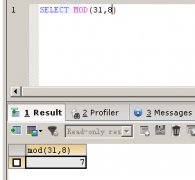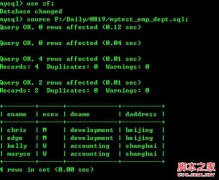手把手教你实现MySQL双机数据同步(1)
编者按:很多朋友一开始接触MySQL双机同步需求的时候可能会感到不知道从哪里入手,事实上这是MySQL本身就支持的功能之一。本文提供有关MySQL主从同步的初步思路,供大家参考。
一.需求问题
假设目前有两台 MySQL 数据库服务器,如何实现这两台机器的数据同步问题?即在一台机器上修改数据库后,另一台机器会同步更新所修改的信息。
二.解决方案
查资料发现 MySQL 支持单向,异步复制,复制过程中一个服务器充当主服务器,而另一个或多个其他服务器充当从服务器。
原理是这样的:
主服务器将更新写入二进制日志文件,并维护文件的一个索引来跟踪日志循环。这些日志可以记录发送到从服务器的更新。当一个从服务器连接主服务器时,它通知主服务器从服务器在日志中读取的最后一次成功更新的位置。从服务器接受从那时起发生的任何更新,然后封锁并等待主服务器通知新的更新。
2.1 测试环境
- Master : 192.168.7.67 (CentOS 5.5 x86_64 ) MySQL Version : 5.0.77
- Slave: 192.168.56.103 (CentOS 5.3 i386) MySQL Version : 5.0.45
备注:
Master 和 slave 端的 MySQL 版本最好要一样的,或者 Master 端的版本高于 Slave 端
2.2 配置过程
2.2.1 Master 端设置
开启 MySQL 服务并新建一个测试数据库 abc:
- root@camlit ~: /etc/init.d/mysqld start
- jian.ma@camlit ~: mysql -u root -p
- Enter password: xxxx
- Welcome to the MySQL monitor. Commands end with ; or g.
- Your MySQL connection id is 3
- Server version: 5.0.77 Source distribution
- Type 'help;' or 'h' for help. Type 'c' to clear the buffer.
- mysql> create database abc;
- Query OK, 1 row affected (0.31 sec)
- ###创建一个用来同步的用户,指定只能在 192.168.56.103 登录
- ###REPLICATION SLAVE: Enable replication slaves to read binary log events from the master
- mysql> grant replication slave on *.* to 'test1'@'192.168.56.103' identified by 'test1';
- Query OK, 0 rows affected (0.16 sec)
修改配置文件:
- root@camlit ~: vi /etc/my.cnf
备注:在修改配置文件之前做好该文件的备份工作。
- [mysqld]
- datadir=/var/lib/mysql
- socket=/var/lib/mysql/mysql.sock
- user=mysql
- old_passwords=1
- ##增加下面内容
- server_id=1###1 表示 master, 2 表示 slave binlog-do-db=abc ###需要同步的数据库,如果有多个数据库,每个数据库一行 binlog-ignore-db=mysql###不需要同步的数据库 log-bin=mysql-bin
- [mysqld_safe]
- log-error=/var/log/mysqld.log
- pid-file=/var/run/mysqld/mysqld.pid
重启服务:
- root@camlit ~: /etc/init.d/mysqld restart
2.2.2 Slave 端设置
和 master 端一样创建一个相同的数据库: abc
- Enter password:
- Welcome to the MySQL monitor. Commands end with ; or g.
- Your MySQL connection id is 5
- Server version: 5.0.45-log Source distribution
- Type 'help;' or 'h' for help. Type 'c' to clear the buffer.
- mysql> create database abc;
- Query OK, 1 row affected (0.31 sec)
修改配置文件:
- root@test2 ~: vi /etc/my.cnf
- [mysqld]
- datadir=/var/lib/mysql
- socket=/var/lib/mysql/mysql.sock
- user=mysql
- old_passwords=1
- ###增加下面内容
- server_id=2 log-bin=mysql-bin master-host=192.168.7.67 master-user=test1 master-password=test1 master-port=3306 master-connect-retry=10 ###连接次数 replicate-do-db=abc ###接受的数据库名 replicate-ignore-db=mysql ###不要接受的数据库
- [mysqld_safe]
- log-error=/var/log/mysqld.log
- pid-file=/var/run/mysqld/mysqld.pid
重启服务:
- root@test2~: /etc/init.d/mysqld restart
备注:
配置成功 后会在 mysql 目录(/var/lib/mysql/)下生成 master.info 文件,如果要更改 slave 设置,要先将该文件删除才会起作用。
进入 mysql,输入下面命令:
- root@test2~: mysql -u root -p
- Enter password:
- Welcome to the MySQL monitor. Commands end with ; or g.
- Your MySQL connection id is 4
- Server version: 5.0.45-log Source distribution
- Type 'help;' or 'h' for help. Type 'c' to clear the buffer.
- mysql> slave start;
- Query OK, 0 rows affected, 1 warning (0.00 sec)
- ###查看同步情况
- mysql > show slave status; 或 show master status;
2.3 结果测试
在 Master 端进行数据库 abc 的一些操作,如下所示:
- jian.ma@camlit ~: mysql -u root -p
- Enter password:
- Welcome to the MySQL monitor. Commands end with ; or g.
- Your MySQL connection id is 3
- Server version: 5.0.77-log Source distribution
- Type 'help;' or 'h' for help. Type 'c' to clear the buffer.
- mysql> use abc;
- Database changed
- mysql> create table test1 (IP VARCHAR(20),USER VARCHAR(100), MAIL
- VARCHAR(100));
- Query OK, 0 rows affected (1.20 sec)
- mysql> insert into test1(IP,USER,MAIL) values('192.168.7.66', 'test', 'test@test.com.cn');
- Query OK, 1 row affected (0.06 sec)
在 Slave 端查看是否能够更新:
- root@test2 ~: mysql -u root -p
- Enter password:
- Welcome to the MySQL monitor. Commands end with ; or g.
- Your MySQL connection id is 6
- Server version: 5.0.45-log Source distribution
- Type 'help;' or 'h' for help. Type 'c' to clear the buffer.
- mysql> show databases;
- +--------------------+
- | Database |
- +--------------------+
- | information_schema |
- | foo|
- | mysql |
- | test |
- |abc |
- +--------------------+
- 5rows in set (0.00 sec)
- mysql> use abc;
- Reading table information for completion of table and column names
- You can turn off this feature to get a quicker startup with -A
- Database changed
- mysql> show tables;
- +---------------+
- | Tables_in_abc |
- +---------------+
- | test1 |
- +---------------+
- 1 row in set (0.03 sec)
- mysql> select * from test1;
- +--------------+------+------------------+
- | IP | USER | MAIL |
- +--------------+------+------------------+
- | 192.168.7.66 | test | test@test.com.cn |
- +--------------+------+------------------+
- 1 row in set (0.00 sec)
从上面的结果可以看到 Master 端的数据可以同步到 Slave 端里面。说明此时主从数据库的同步问题已经成功解决。
- 上一篇:微博 请问你是怎么优化数据库的?
- 下一篇:一起学习MySQL源码笔记之偷窥线程






